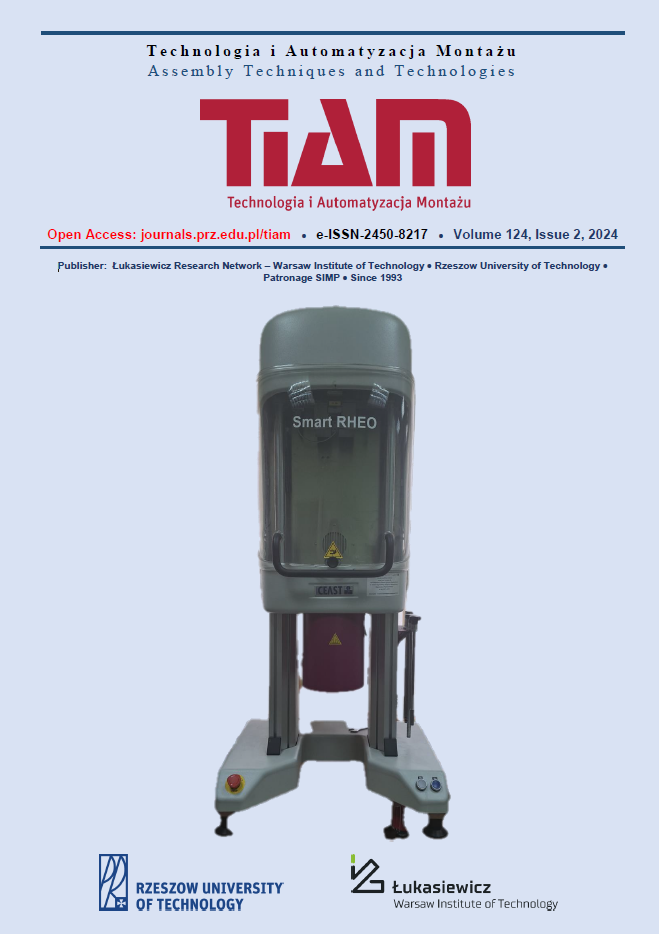Abstract
The publication presents the test method and construction of a compact VOC emission test chamber. Volatile organic compounds (VOCs) are mainly occur in paint and construction materials containing chemical resins, bitumen, binders, adhesives, etc., as well as residues of unreacted monomers. VOC emission testing is carried out on product samples in environmental chambers in accordance with PN-EN ISO 16000-9. The developed chamber, together with a proprietary control and test parameter acquisition system, allows testing at a stabilized temperature and humidity of air washing over the sample at a specified rate. Qualitative identification and quantitative testing of compounds present in the air inside chambers is carried out using a chromatograph, and the test results are compared with regulations on permissible chemical pollutants in the air of buildings and in atmospheric air. The developed chamber with horizontal sample loading is another version of VOC chambers, developed in response to market demands, offered and implemented in research laboratories by the Łukasiewicz Institute for Sustainable Technologies in Radom.
References
Afshari A., Lundgren B., Ekberg L. E. (2003). Comparison of three small chamber test methods for the measurement of VOC emission rates from paint. Indoor air, 13, 156-165.
Boczkaj G., Przyjazny A., Kamiński M. (2014). Characteristics of volatile organic compounds emission profiles from hot road bitumens. Chemosphere, 107, 23-30.
Demeestere K., Dewulf J., De Roo K., De Wispelaere P., Van Langenhove H. (2008). Quality control in quantification of volatile organic compounds analysed by thermal desorption-gas chromatography-mass spectrometry. Journal of Chromatography, 1186, 348-357.
Invernizzi M., et al. (2021). Lights and shadows of the VOC emission quantification. Chemical Engineering Transactions, 85, 109-114.
Kozioł S., Matecki K., Samborski T., Siczek M., Wojutyński J., Zbrowski A. (2019). Overpressure chamber for testing in high air purity conditions. Journal of Machine Construction and Maintenance, 114, 81-90.
Liu WeiWei, et al. (2012). Indoor decorating and refurbishing materials and furniture volatile organic compounds emission labeling systems: A review. Chinese Science Bulletin, 57, 2533-2543.
Niesłochowski A. (2013). Badanie emisji lotnych związków organicznych (VOC) techniką termicznej desorpcji i chromatografii GC-MS. Prace Instytutu Techniki Budowlanej. Vol. 42, 9-20.
Oppl R. (2014). New European VOC emissions testing method CEN/TS 16516 and CE marking of construction products. Gefahrstoffe-Reinhaltung der Luft, 74, 62-68.
PN-EN ISO 16000-9:2009 Indoor air. Determination of the emission of volatile organic compounds from building products and furnishing. Emission test chamber method.
Ribes A, Carrera G., Gallego E., Roca X., Berenguer M.A., Guardino X. (2007). Development and validation of a method for air-quality and nuisance odors monitoring of volatile organic compounds using multi-sorbent adsorption and gas chromatography/mass spectrometry thermal desorption system. Journal of Chromatography A, 1140, 44-55.
Regulation of the Minister of Environment dated 5 December 2002 on reference values for certain substances in the atmosphere (Journal of Laws of 2003, No. 1, item 12),
RP xxxxxxx
Wei Wenjuan, et al. (2012). A standard reference for chamber testing of material VOC emissions: design principle and performance. Atmospheric Environment, 47, 381-388.
Ordinance of the Ministry of Health and Social Welfare dated 12 March 1996 on the permissible concentrations and intensities of harmful factors for health, emitted by building materials, equipment and elements of equipment in rooms intended for human occupation (Official Journal of the Republic of Poland of 1996, No. 19, item 231).
Zhibini Z. et al. (2003). Determination of Volatile Organic Compounds in Residential Building. Proceedings of the International Conference on Indoor Air Quality Problems and Engineering Solutions, https://doi.org/10.1177/1420326X9600500404.

